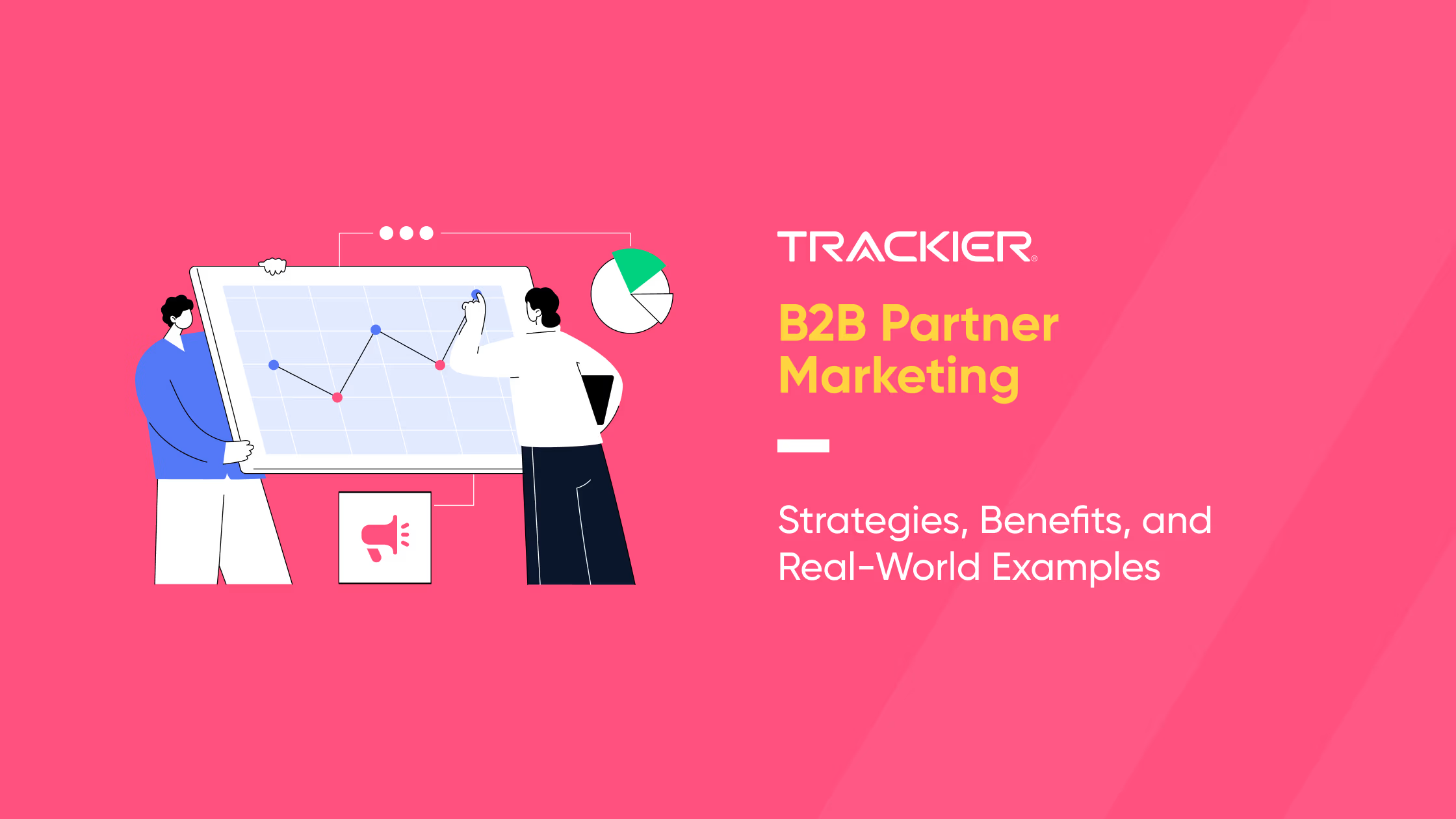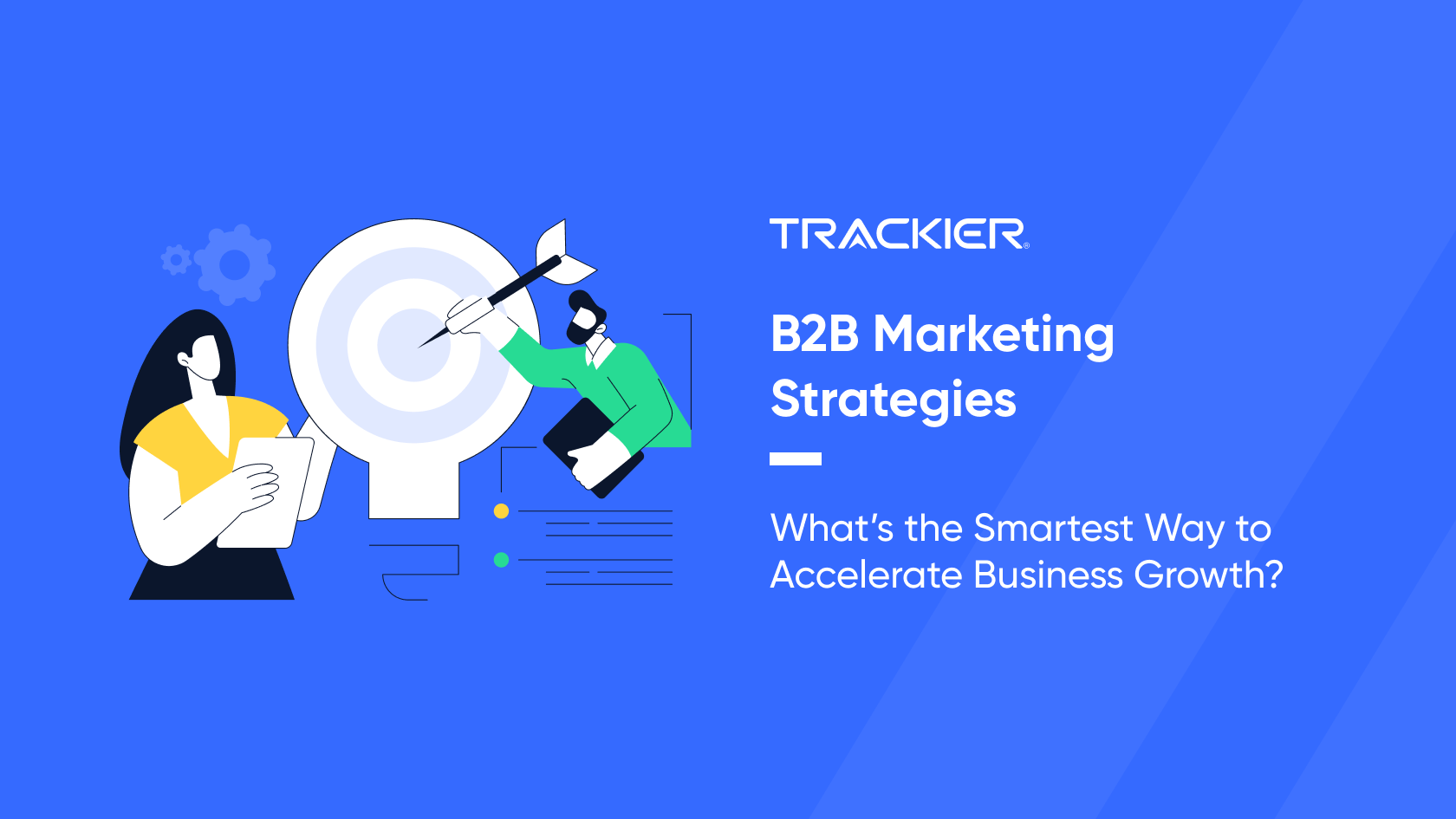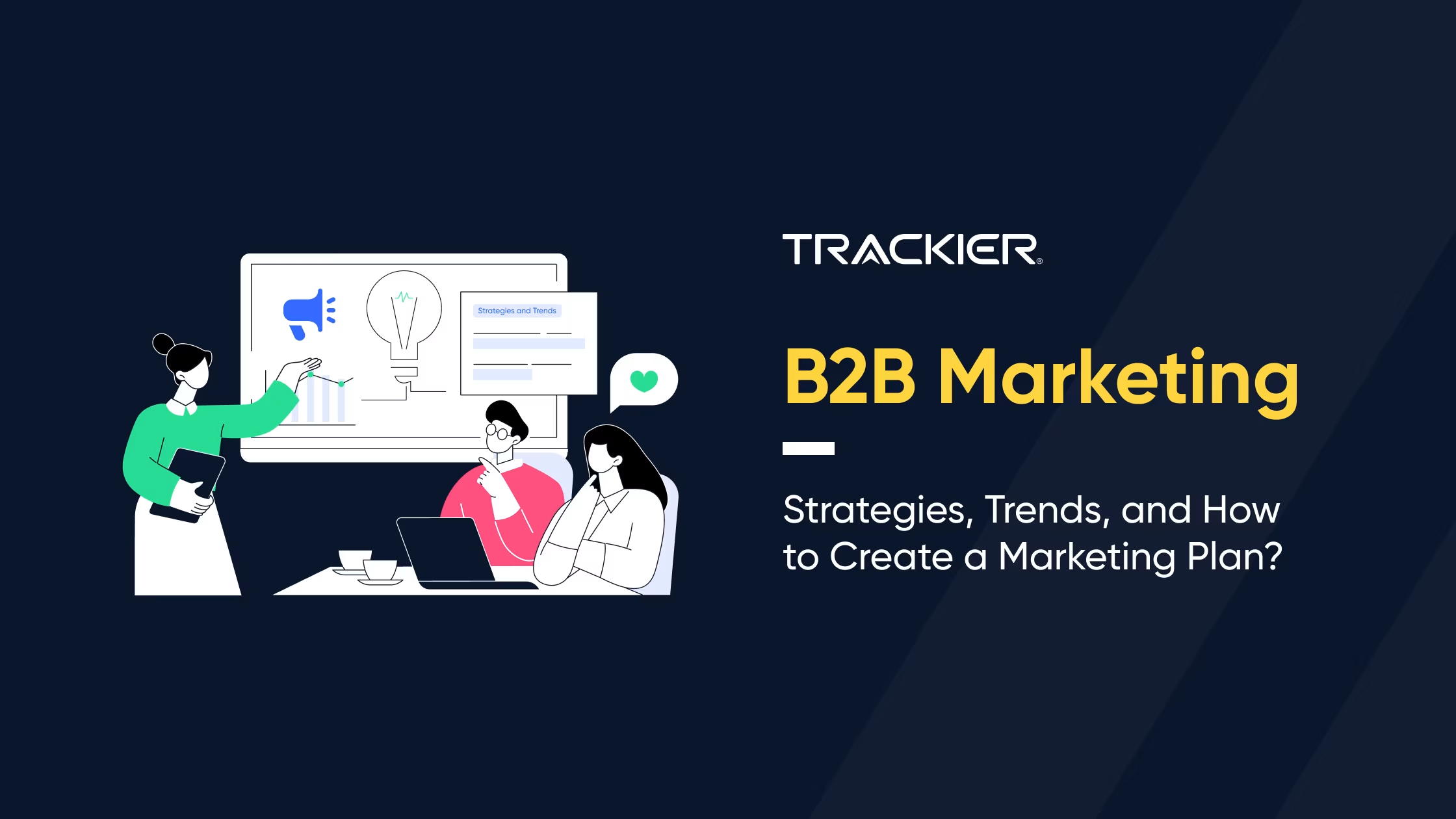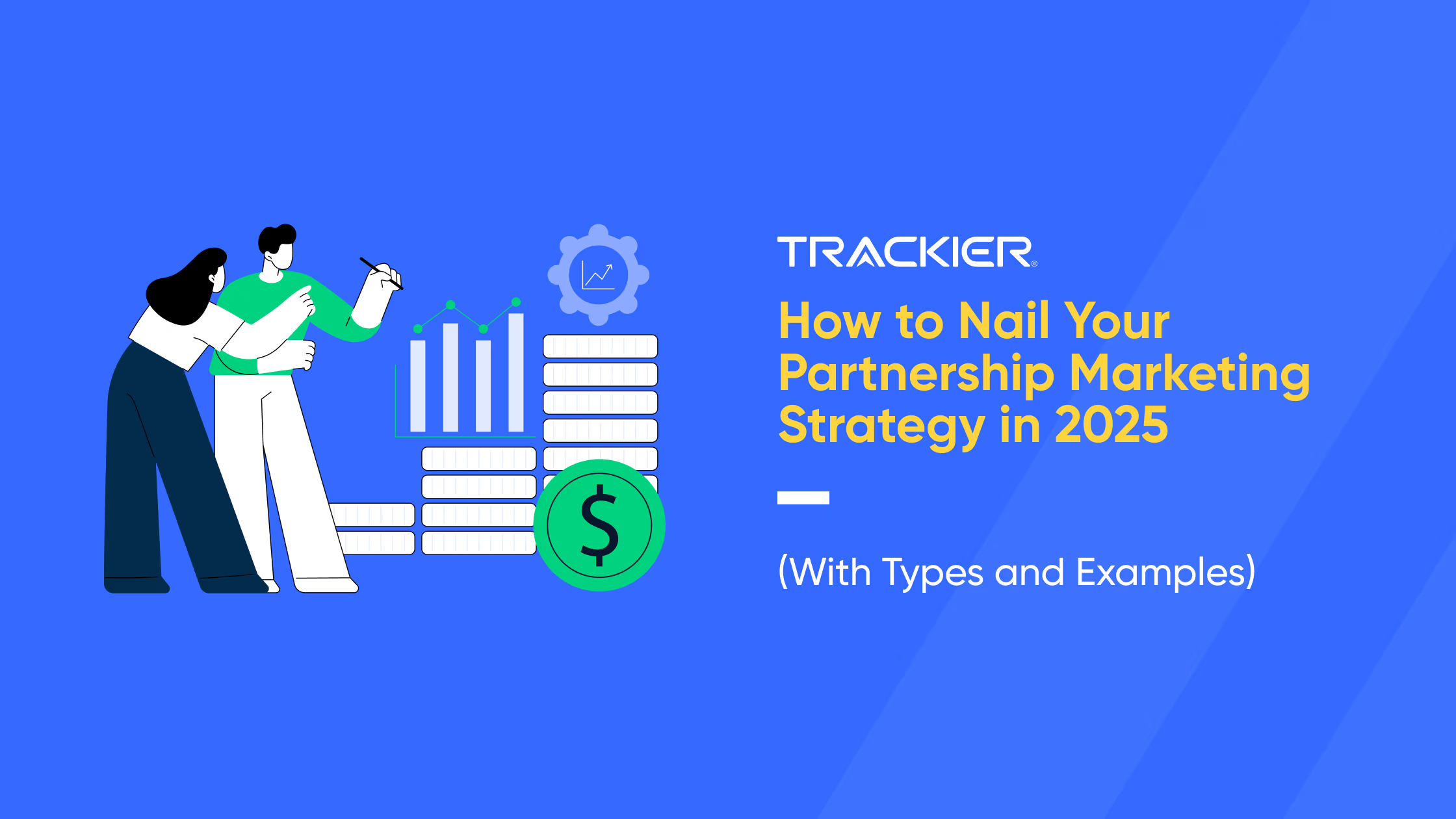Think of your favorite salesperson who never takes a day off, works in every time zone, and has gained the trust of your ideal customers. This is the kind of value a comprehensive partner ecosystem can bring to your business.
Research shows that by 2025, the revenue driven by partners will surpass revenue driven by customers, and many of the top companies are already generating 58% of their sales through partners.
B2B partner marketing is not just about signing a partnership agreement and hoping that something sticks for you both. It is about creating trackable, measurable, and scalable campaigns that are mutually beneficial to everyone involved.
That is where Trackier comes in. With real-time tracking, fraud prevention, and flexible commission models, it will take your B2B partner marketing campaigns from “I hope this works,” to “this works, look at the numbers.”
Have you found yourself asking:
- What is B2B partner marketing?
- What types of marketing partnerships really work?
- And, how do you measure success without spending all of your time in spreadsheets?
By the end of this blog, you will have a complete B2B partner marketing strategy you can implement, complete with practical tools, real examples, and even a partner campaign launch checklist that you can download for free.
What is B2B Partner Marketing?
B2B partner marketing is a long-term growth partnership between two or more companies to promote each other’s products and services for shared benefit. B2B partner marketing can be visualized as a form of collaborative ecosystem, in which businesses share audiences, expertise, and trust to generate revenue faster than either could do alone.
For example:
- A software vendor collaborates with a consulting firm to recommend its tool to their clients.
- An agency of designers suggests a project management platform to their clients for referral commissions.
These are all different types of marketing partnerships that are fair value exchanges to drive the desired partner financial outcome. By partnering with another business whose value you can leverage, you can achieve a level of growth that would be impossible to do as an independent business.
Benefits of B2B Partner Marketing
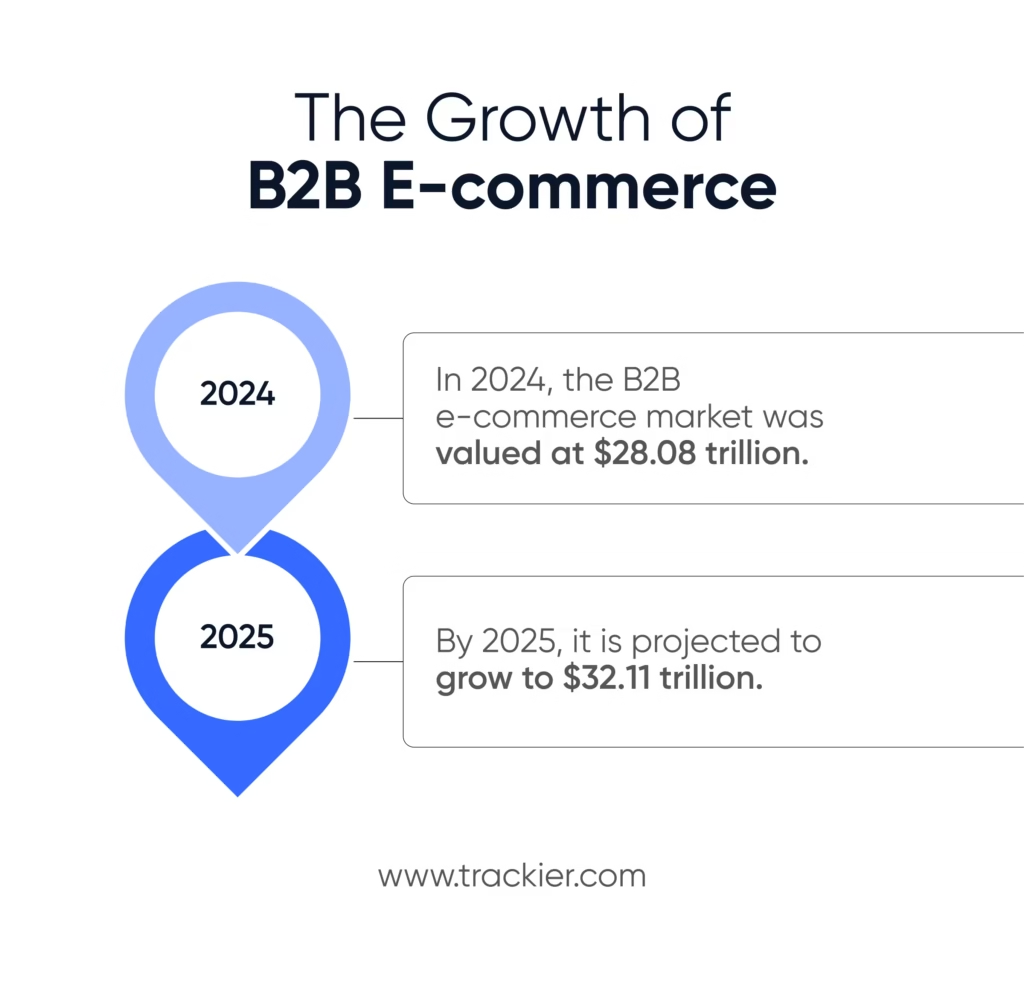
If done properly, B2B partner marketing campaigns have benefits that extend well beyond a single campaign:
- Cost-effective customer acquisition – One of the most significant benefits is the efficiency of customer acquisition. A study shows that a staggering 66.7% of salespeople reach out to 250 or fewer leads per year. That is why you need lead generation efficiency. Partner marketing programs are generally performance-based. The result? Your customer acquisition costs will be reduced.
- More trust and credibility – When a reputable partner shares your product, you become part of their credibility. Third-party recommendations are powerful. Your new customers are already predisposed to have a positive association with and trust in you, which has the potential to decrease the length of your sales cycle.
- Expanded market reach – Partners will introduce you to new markets and customer segments, which you may not have touched otherwise. By partnering with a business that already serves an audience that complements yours, you gain access to a set of prequalified potential customers.
- Access to new resources and expertise – Strategic partnerships can open new doors to technology, distribution channels, or expertise that you otherwise did not have access to internally. For startups and small businesses, this access can be an important value proposition, opening up options for them to grow quickly.
- Accelerate revenue – Channel-based campaigns create indirect sales: “By 2025, indirect revenue is anticipated to double direct revenue growth by as much as 30%”, significantly strengthening overall market share and competitive positioning for businesses.
Grow Your Business with Performance Marketing Software
Types of B2B Partnerships
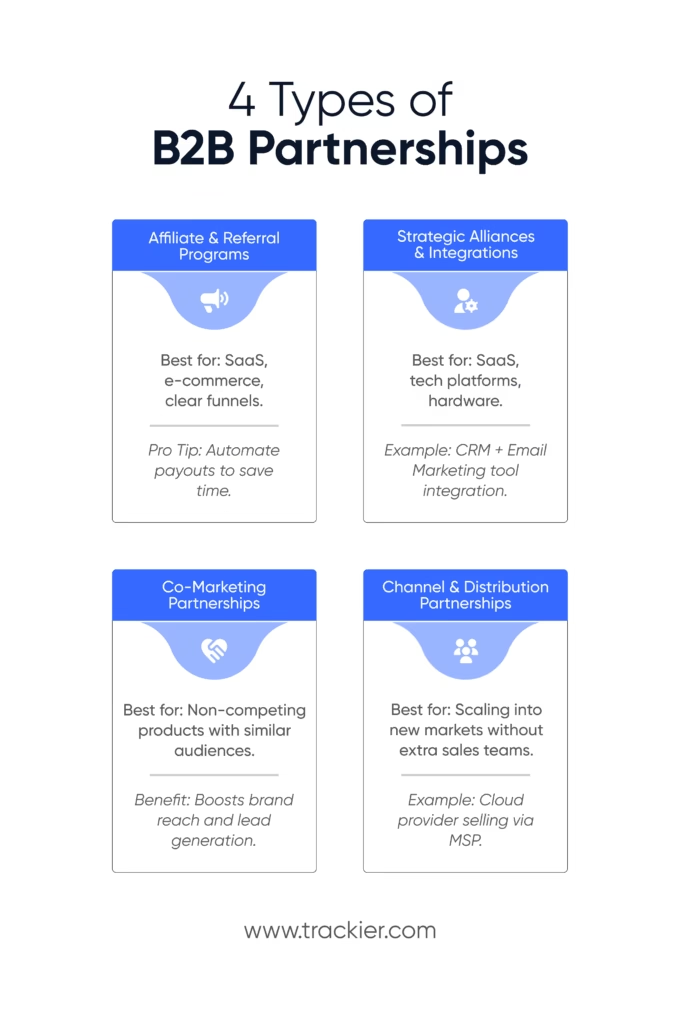
Understanding the different types of marketing partnerships is key when developing your B2B partner marketing strategy. Not every collaboration is equal, and selecting one over the other depends on your motivations as a business.
1. Affiliate and Referral Programs
This is the most popular type of B2B partner marketing campaign and involves you collaborating with individuals or companies to promote your product and receiving commissions for each referral or sale generated from your partner. This model works best when a company has a clear, measurable customer journey.
Who it is for: SaaS companies, e-commerce brands, and any business that has a clearly defined conversion funnel.
2. Strategic Alliances and Integrations
Strategic alliances and integrations are even more advanced business to business collaboration models. Here, two companies that offer complementary products or services together bundle their offerings to create a more compelling deal for their shared customer. This collaboration usually consists of a combination of co-selling or other forms of joint marketing.
Who it is for: SaaS and technology companies, platforms, and hardware manufacturers.
3. Co-Marketing Partnerships
Co-marketing refers to developing campaigns and content as a team. This could include a co-authored report, a joint webinar, or an e-book. Co-marketing is an excellent way to engage audiences, boost organic reach, generate new leads, and leverage resources.
Who it is right for: Companies with an identical target audience that sell complementary products.
4. Channel and Distribution Partnerships
A B2B channel partner marketing means that one company sells another company’s product or service. This could be through resellers, value-added resellers (VARs), or managed service providers (MSPs).
Who it is for: Companies looking to expand their sales reach into new regions or verticals without the time and expense of building a dedicated internal sales team.
KPIs for B2B Partner Marketing Campaigns
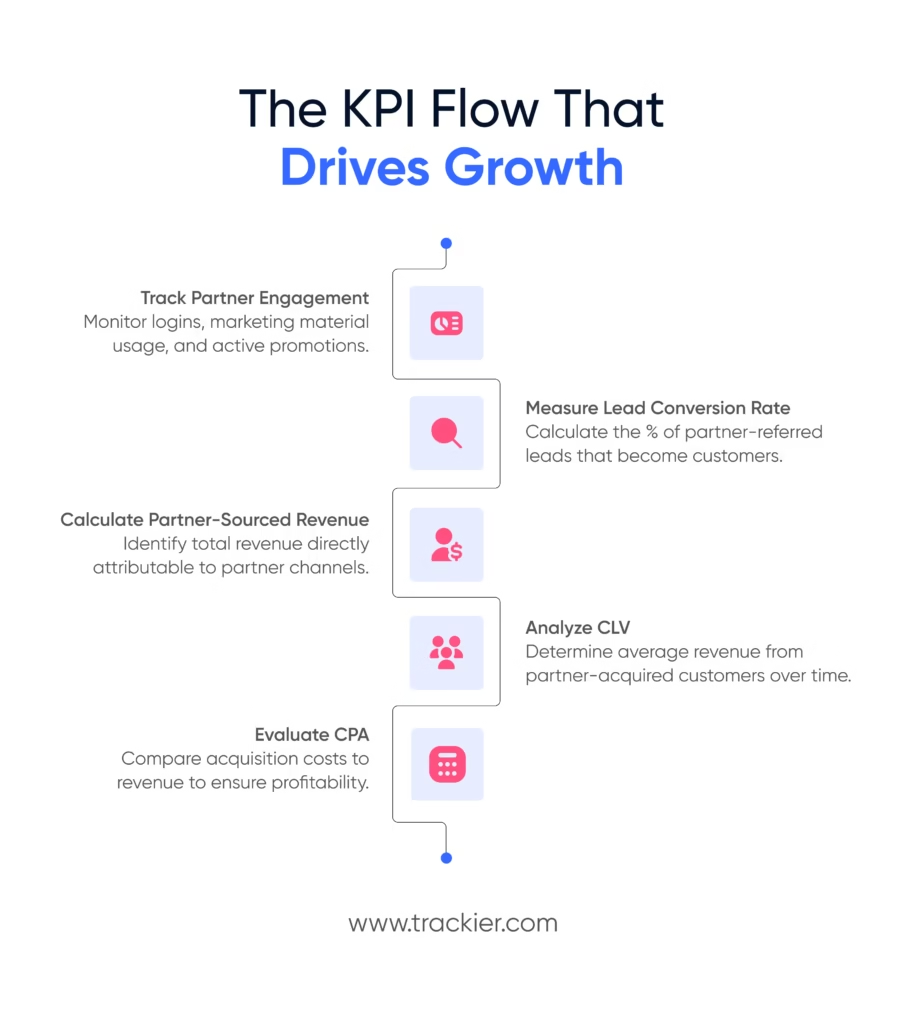
You can not manage what you can not measure. A strong B2B partner marketing strategy helps to have a focus on the right key performance indicators. Having a reliable platform to track these metrics, and in real-time, is also important.
- Partner-sourced revenue – This is what revenue can be attributed directly to your partner channel. This is the gold standard for measuring the success of any B2B partner marketing campaign.
- Customer lifetime value (CLV) – How valuable is a customer you acquire from a partner over their lifetime? If your partners are bringing you high-quality customers that stick around, this ratio will be high.
- Conversion rate – What percentage of partner-referred leads are turning into customers? This metric can tell you something about the quality of the leads that a partner is sending you.
- Partner engagement – This KPI is not just a number; it is a measure of partner health. Are your partners logging into their dashboard, downloading and using your marketing materials, and promoting your product? A healthy partner channel is an active partner channel.
- Cost per acquisition (CPA) – How much do you spend to acquire a customer through a particular partner? If you track this closely, you help ensure your partnerships are profitable.
Track Your Partners’ Performance with Marketing Analytics
B2B Partner Marketing Strategy: Top 5 Tips for Success
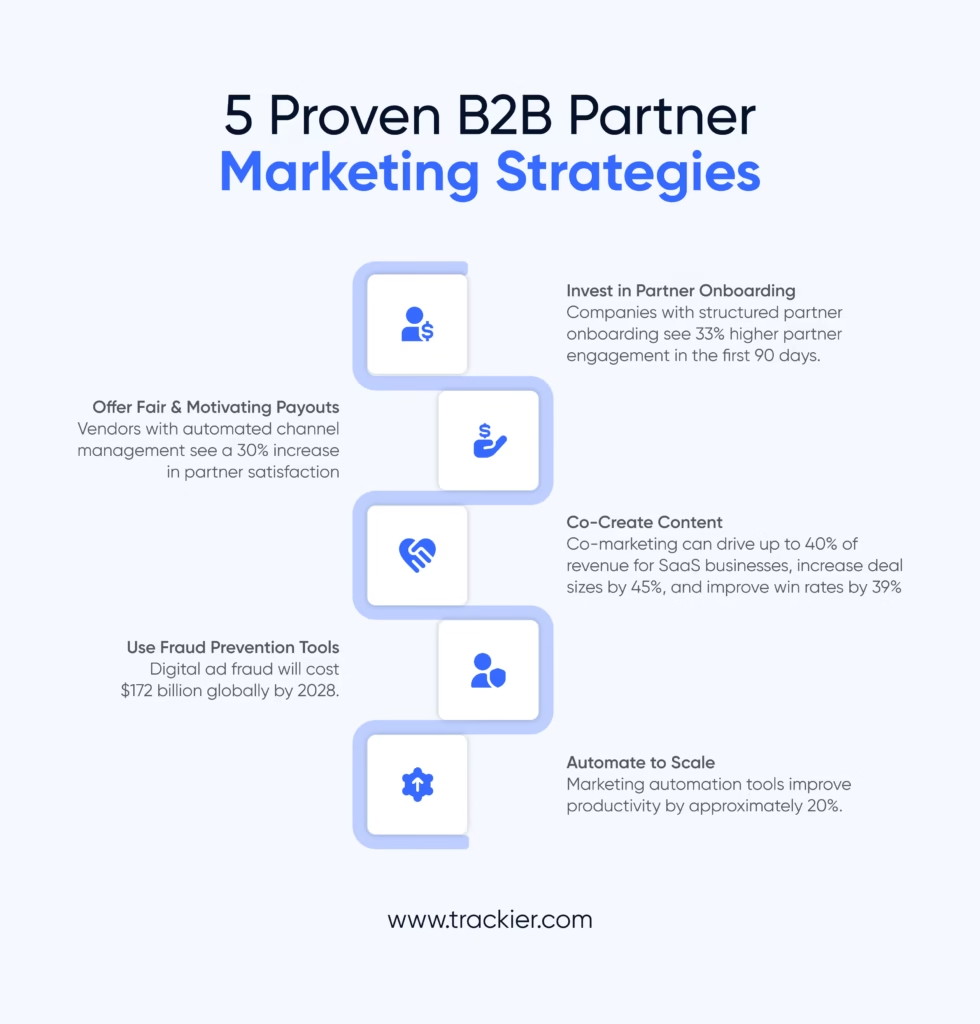
Your B2B partner marketing strategy should not simply be passive sign-ups. This should be a valid active engagement and a way to create a system where everyone wins.
1. Invest in Your Partner Onboarding Experience
Your partners are an essential part of your sales and marketing team, and if your onboarding process is clunky, there will be a very high chance that they are turned off. So, instead of just providing a link, provide partners:
- A partner portal with banners, email templates, and case studies.
- A 30-day quick-start plan navigating them to the quickest way to achieve results.
- On-demand training videos or webinars.
- A dedicated success manager or Slack channel for support.
2. Offer Fair and Motivating Payout Structures
There is nothing more motivating to a partner than a fair payout. If you have considered a tiered commission structure, incentivizing top performers with higher commission rates, you should be transparent about when you pay your affiliates and design a pay structure that pays consistently, with no missed payouts.
According to Adobe, 77% of senior marketing executives are being asked to produce growth using data and AI. Therefore, it is in your best interest to be data-driven and efficient in how you give access and allocate grades to your partners.
So, provide them:
- Tiered commissions to reward top performers
- Be clear about the timeline for payments
- Automate payments to avoid missed payment dates
3. Utilize Co-Branded Content and Case Studies
The power of co-creating content can not be overstated. Co-creating content is a great way to build authority and generate leads. Partner up with a complementary business to produce an e-book, a webinar, or a comprehensive report.
This is also an opportunity to create B2B partner marketing examples to showcase your value as a group. Co-authoring with another business is a great way to show what a business to business collaboration can look like in practice. So,
- Initiate joint webinars, author co-branded eBooks, or share customer success stories.
- Leverage both audiences to maximize organic reach and lead generation. For example, A CRM company and email marketing platform co-create a “Scaling Your Customer Base” guide.
4. Use Fraud Prevention
The larger your program grows, the greater the chance of becoming a victim of fraud. Your budget can be drained by clicks from bots or sign-ups made from accounts that are fraudulent accounts.
Red flags will skew your data, which is found in your tracking software. You need a next-gen platform that at least has fraud prevention features. Trackier’s fraud prevention helps you to:
- Use click and conversion filters to prevent duplicates or bots.
- Monitor IP patterns and trends in suspicious traffic spikes.
5. Utilize Automation to Scale
If you only have a few partners to manage, managing it manually is easy. But if you are scaling to hundreds or thousands of partners, everything can quickly become completely unmanageable.
To make scaling easier, you have to automate your whole process. So, use a performance marketing software to:
- Automate commission tracking, partner reporting, and onboarding steps.
- Use dashboards to manage hundreds of partners at scale as opposed to spreadsheets.
Tools and Platforms For Your B2B Partner Marketing Program
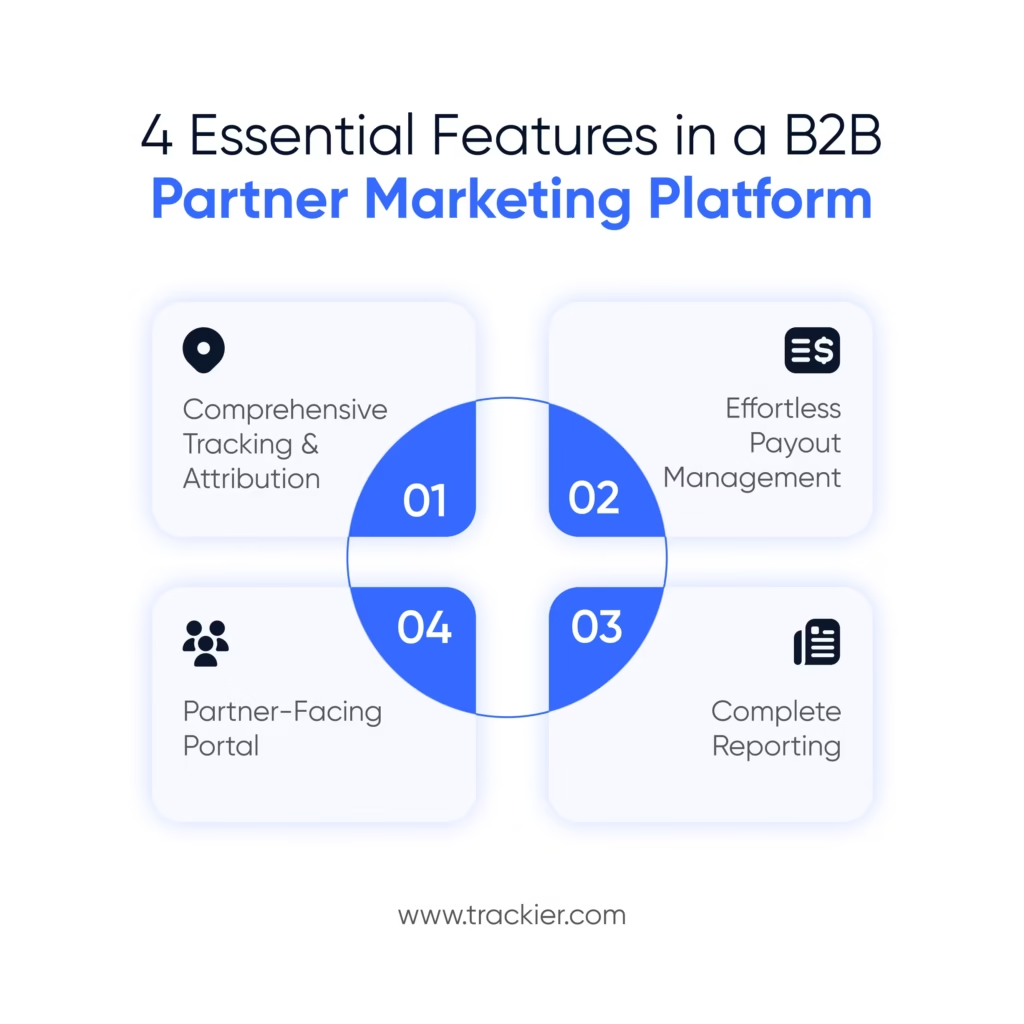
You can try to run your program with spreadsheets and manual emails, but it will be very difficult. In fact, 48% of marketers increased their budgets for B2B marketing technology in the past year.
A dedicated platform is essential for scaling a B2B partner marketing strategy. Here is what a good platform should offer:
- Comprehensive tracking and attribution – You need to know exactly which partners are driving which results. A platform with advanced tracking capabilities, like Trackier, gives you a granular view of every click and conversion. This is the foundation of a performance-based program.
- Effortless payout management – Managing payments for partners across different regions using different currencies can be a big challenge. You will need a platform with automated payout features and options for multiple payment methods and tax forms (like W-9 or W-8BEN for partners in the U.S).
- Complete reporting – You will need real-time dashboards and accurate reporting. If you want to make decisions, you should look for a tool that enables you to analyze everything with a 360-degree view of your B2B partner marketing campaigns and tell which channels are performing and which are not.
- Partner-facing portal – Providing your partners with a pro-level portal that is easy to use, where they can access everything they need, is a big benefit. Things available can be marketing assets, real-time performance stats, a knowledge centre, and a platform where you can showcase successful B2B partnerships.
Real-World B2B Partner Marketing Examples
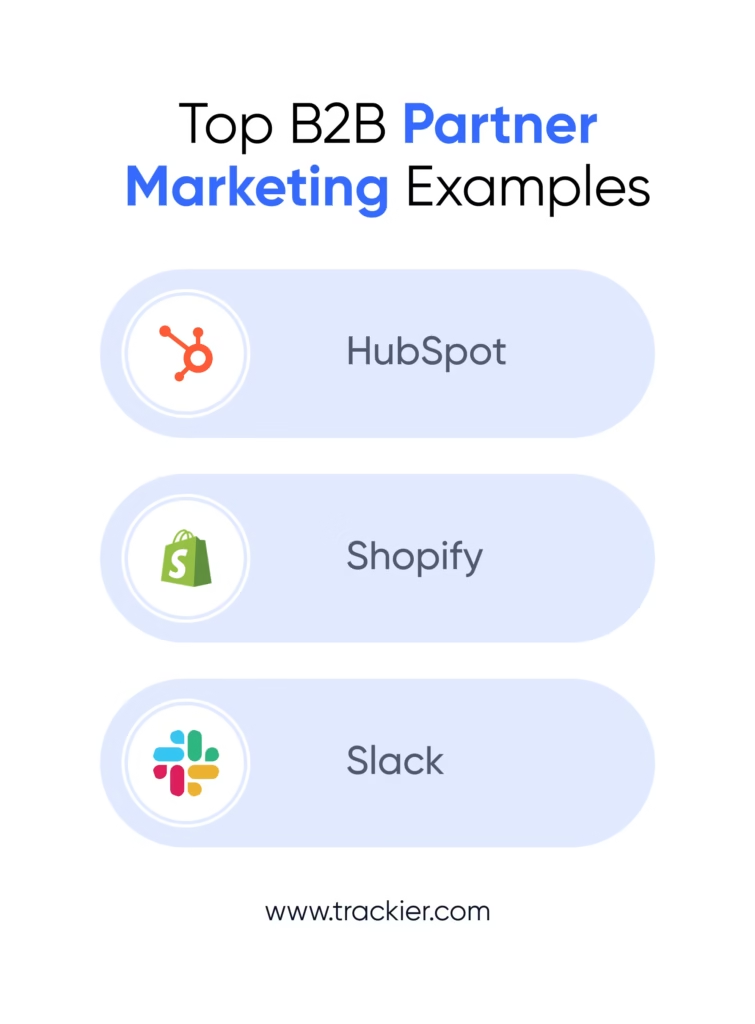
Having B2B partnership examples of success can help to make your own successful B2B partner marketing strategy. Here are just a few examples:
1. The HubSpot App Marketplace
HubSpot is one of the biggest CRM and marketing platforms that has developed a comprehensive alliance with its partners.
Their app marketplace is clear evidence of a successful strategic alliance in action. HubSpot allows companies to integrate their tools, which adds to a solution for HubSpot users.
For partners, HubSpot offered access to a huge base of existing customers. It is a win for all parties involved, and this is a fantastic model for a successful business-to-business relationship.
2. Shopify and Its Partner Ecosystem
The successful brand Shopify is continuously growing its partner program. The wide range of app developers, theme designers, and marketing providers helps merchants grow their stores.
This business-to-business distribution opportunity is so powerful that Shopify derives a majority of its revenue from its partners. This alone shows that the opportunity exists and is scalable to profit.
3. Slack’s App Directory
Slack is an excellent example of an organization that has implemented strong B2B partner marketing to create a focal point for workplace communications.
Slack did not build a chat app; they built an ecosystem. Their app directory has thousands of integrations with other business tools such as Google Drive, Asana, and Trello.
This form of partnership gave Slack users the ability to streamline the workflow, while allowing Slack partners access to a huge, engaged user base.
The outcome is a more comprehensive product for all, and a network effect that boosts Slack’s growth and places the SaaS product more firmly as a “Digital HQ” for teams. This is the best example of an integration partnership that benefits all.
Common Mistakes to Avoid With Your B2B Partnership Program
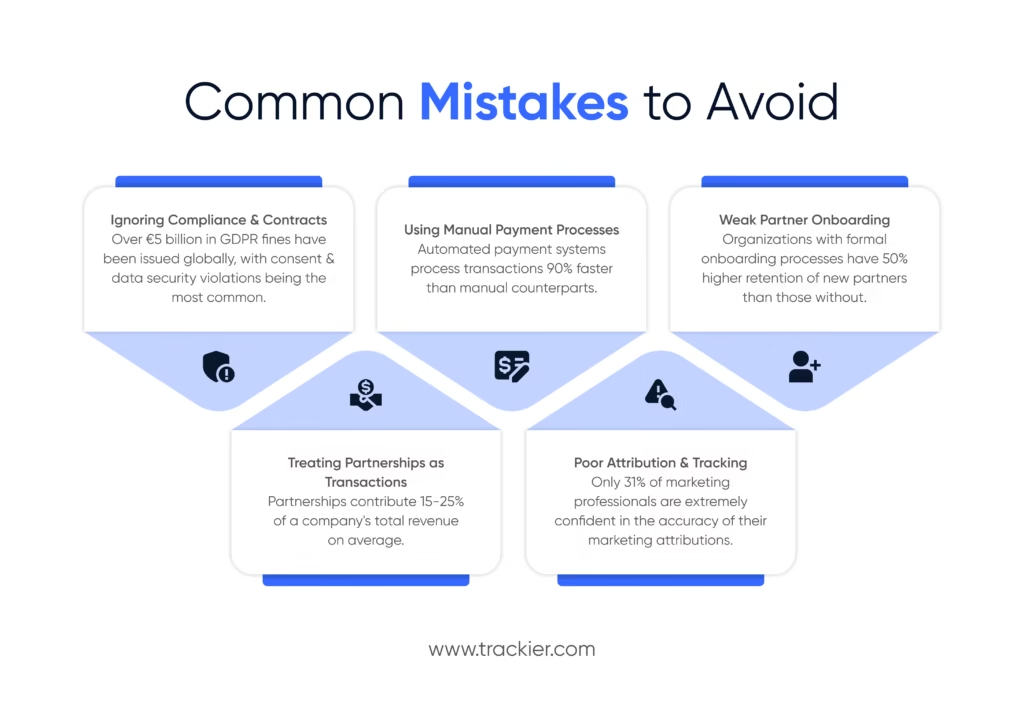
Starting a program is one thing; making it successful is another. Let’s talk about some areas to avoid:
- Ignoring compliance and contracts – Compliance is always a priority; make sure GDPR/CCPA compliance is taken care of, sign updated contracts, and ensure global payouts follow suit. And do not forget about GST/PAN for your Indian partners.
- Ignoring the partnerships – Remember, partnerships are relationships and not transactions. You must put effort into building and maintaining relationships. Share regular updates with partners, offer support, and remember to celebrate their success.
- Using manual processes for payments – Managing payments manually becomes impossible as programs scale. You are only setting yourself up for an error-prone process. Look for a platform that offers automated payouts (for example, Trackier). You can not afford to get bogged down in payment management.
- Poor attribution and tracking – If you can not tell where your leads and sales are coming from accurately, then you can not make informed decisions. You run the risk of paying for results that are not real or overlooking the opportunity to reward your top partners.
- Underestimating the onboarding of partners – You can not simply give a partner a link and expect them to generate results. They need a clear path. They need the best tools, and they need an understanding of your brand.
Prevent Costly Errors with Trackier’s Fraud Prevention
Future Trends in B2B Partner Marketing

The sector of B2B marketing is constantly evolving. Anticipating and adapting to these trends puts you ahead of the curve. Here are some of the future trends for 2025 and beyond that you can look up to:
- Deeper integration with AI – AI is already an emerging technology. A recent report from Forrester shows that the requirements and complexity for modern B2B partner marketing leaders are continuously rising, and AI-powered tools are uniquely positioned to solve those issues. AI will be used to discover prospective partners, predict performance, and automate more of the workflow, resulting in more efficient programs.
- Expansion of influencer and micro collaborations – The future of B2B partner marketing examples does not just include the big brands. There will be more collaborations with niche influencers and microbrands who have deeply engaged, specialized audiences. And while these B2B collaboration efforts are smaller, because of the trust these influencers have with their followers, they often have a much higher conversion rate.
- Think about ecosystems, not campaigns – The shift is away from singular campaigns to building interconnected ecosystems. The goal is to create a network of partners to provide your customers with a collective and holistic offer.
- Better compliance and transparency – With the rise of data privacy regulations, transparency will be even more important than before. Platforms will need to ensure there are options available for compliance to keep partner trust. Trackier, for example, has features built into the platform to assist you in managing and complying with data privacy initiatives.
- Omni-channel strategies – Now, nearly 74% of today’s B2B customers conduct extensive searches online before proceeding with their offline purchase decision, underscoring the need for cross-channel engagement. By 2025, successful B2B marketing will need to ensure you have a seamless digital presence across multiple platforms to meet buyers where they are looking for information.
Future-Proof Your Campaigns with Our Integrations
Conclusion: Your Next Move
Partner marketing is more than an additional channel; it is a highly effective, sustainable growth strategy. The winners in 2025 will:
- Build trust-based partnerships
- Empower partners with tools and data
- Diligently measure performance
- Automate processes that do not need to be done manually
If you want to simplify tracking, prevent fraud, process payments better, and find a deeper perspective into performance, you don’t have to solve that on your own.
Trackier can help you work faster, smarter, and more efficiently while you focus on building real relationships with your partners.
Ready to see how? Book a Demo!
FAQs
1. How does partner marketing differ from traditional marketing strategies?
Partner marketing is about working with two or more companies to achieve shared goals, expand brand reach, generate leads, and increase revenue. In traditional marketing, a brand promotes itself without the use of any partners or collaborators. In partner marketing, the brand works to leverage the partner’s audience, credibility, and resources to create joint marketing campaigns.
2. What industries can benefit the most from partner marketing?
Partner marketing is useful in all industries, but it is especially impactful in industries centered on trust, niche expertise, and large customer bases. In particular, the SaaS industry, e-commerce, technology, fintech, healthcare, education, and travel utilize partner marketing effectively. Industries that have complementary services (like software integrations, bundled capabilities, etc.) see better value from partner marketing.
3. What are the most common types of B2B Partner Marketing?
The most common types are:
Technology partnerships – Integrations that add value to both customer bases.
Affiliate marketing – Paying partners for leads or sales.
Referral partnerships – Get partners to refer customers that fit your ideal customer profile.
Co-marketing – Joint campaigns of a webinar, eBook, or an event together.
Reseller partnerships – Partners that sell your product as part of their delivery.
4. How can I measure the success of a B2B Partner Marketing campaign?
Defining success is always the same. Measuring success begins with knowing your KPIs. Following those, report on your metrics like partner-sourced revenue, leads created, the lead-to-customer conversion rate, average deal size, engagement on campaigns, etc. Be sure to measure partner performance and content reach, as well as the cost to acquire customers. Software like CRMs, marketing analytics, and partner management can help you confirm accurate measurement.
5. How do you measure ROI in B2B Partner Marketing?
ROI can be calculated by totalling revenue generated from partner-related campaigns, and then comparing this to the total investment made (both in time and resources, and in terms of financial investment). ROI can also include non-monetary factors such as better brand visibility, enhanced market positioning, or a larger customer base.
6. How do you find the right B2B marketing partners?
Identifying the perfect partners means identifying businesses with in-sync offerings, targeting the same audience, and sharing similar brand values. Research the potential partner’s market reputation and engagement levels. Consider attending industry events, using LinkedIn connections, or partnering with marketplaces to help narrow down your possibilities.
